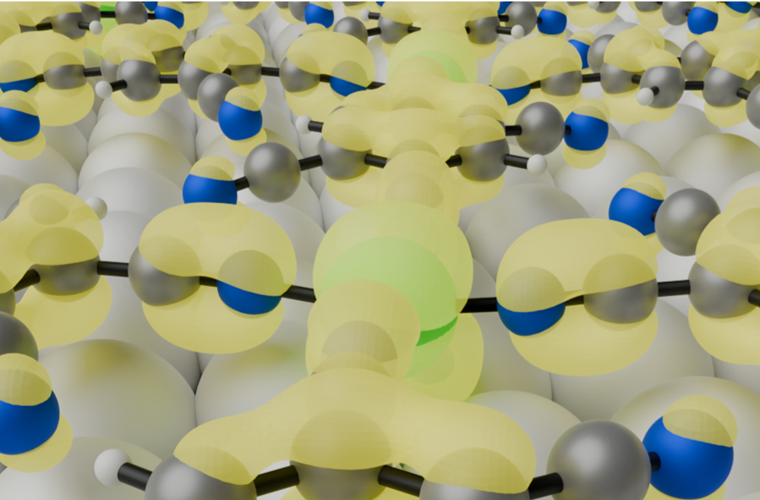Materials engineering in flatland

Aiming at ever thinner materials, one eventually reaches the two-dimensional (2D) limit, where the material ultimately becomes just a few atoms - or even only one atom - thin. In this “flatland”, materials acquire unique mechanical, electronic and optical properties that promise great potential for future innovative technologies ranging from electronic and magnetic devices to materials for energy conversion and storage.
The 2D metal-organic frameworks (2D-MOFs) are a special type of 2D materials, that are made up of metal atoms connected by organic (carbon-based) molecules. They combine the best of both worlds, metals and organic materials, and they hold promise for a wide range of advanced technologies, making our devices smaller, smarter, and more efficient.

Real space structure and momentum band maps representation of the 2D MOF.
“Using a synergistic approach that combines experimental and theoretical methodologies, we provide direct evidence for the emergence of band structure upon the hierarchical assembly of organic linkers and transition metal centers into a 2D-MOF lattice”, says Dr. Vitaliy Feyer.
These studies reveal not only the formation of the band structure but also the inherent multifunctional electronic and magnetic properties of 2D-MOFs, largely independent of the underlying substrate. The findings offer a new perspective on band structure engineering and pave the way for the integration of these materials into future electronic and photonic devices.
The momentum-resolved photoemission experiments were conducted at the Elettra synchrotron facility in Trieste, Italy, where the Jülich group operates NanoESCA beamline, with contributions from Simone Mearini, Dr. Daniel Baranowski, Dr. Vitaliy Feyer, and Prof. Claus M. Schneider. All theoretical investigations for this project were performed by Dominik Brandstetter, Dr. Andreas Windischbacher and Prof. Peter Puschnig from the University of Graz, Austria.
“NFFA-Europe offered a unique opportunity to conduct additional measurements on 2D-MOF in close collaboration with Dr. Luca Floreano and Dr. Luca Schio from the Italian National Research Council, and Dr. Pierluigi Gargiani and Dr. Manuel Valvidares from BOREAS beamline at ALBA synchrotrons”, concludes Feyer.
1. D. Baranowski, M. Thaler, D. Brandstetter, A. Windischbacher, I. Cojocariu, S. Mearini, V. Chesnyak, L. Schio, L. Floreano, C. Gutiérrez Bolaños, P. Puschnig, L.L. Patera, V. Feyer, C.M. Schneider, Emergence of Band Structure in a Two-Dimensional Metal-Organic Framework upon Hierarchical Self-Assembly, ACS Nano, 18 (30), 19618-19627 (2024). https://doi.org/10.1021/acsnano.4c04191
2. S. Mearini, D. Baranowski, D. Brandstetter, A. Windischbacher, I. Cojocariu, P. Gargiani, M. Valvidares, L. Schio, L. Floreano, P. Puschnig, V. Feyer and C.M. Schneider, Band Structure Engineering in 2D Metal-Organic Frameworks, Adv. Sci. (2024) 2404667. https://doi.org/10.1002/advs.202404667
An experimental setup capable of performing XPS and XAS measurements simultaneously was mandatory for the success of the experiment on 2D MOFs. Overall the ALOISA beamline at Elettra, Italy, was best suited for these planned experiments since it was optimized for characterizing molecular layers supported at well-defined interfaces.
To investigate the magnetic properties of 2D MOFs, we required XLD and XMCD measurements across the transition metal L-edge with high energy resolution. The availability of a strong magnetic field (up to 5-6 T) and the ability to conduct measurements at low temperatures (below 5 K) were critical for the success of these experiments. Fast scans, made possible by simultaneous adjustment of the undulator gap and monochromator, were essential for efficient characterization of the 2D MOFs. Given these requirements, the BOREAS beamline at ALBA was ideally suited for studying these 2D materials. Furthermore, the LEED setup available there was invaluable for preparing a reliable starting layer, guided by the reference data we had obtained.

Vitaliy Feyer
Dr. Vitaliy Feyer is a surface scientist at Peter Grünberg Institute of Forschungszentrum Jülich, Germany, specializing in the electronic and geometric structure of interfaces between metal surfaces and organic-based materials. His current research focuses on the experimental study of the geometric and electronic structure of organic thin films and metal-organic frameworks, elucidated by Photoemission orbital tomography using a PhotoEmission Electron Microscope.

